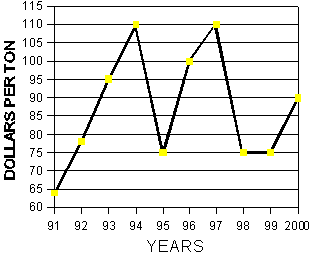Alfalfa Report
Yuma County, Arizona
October 23, 2000
Yuma County Office
2200 W. 28th Street, Ste. 102
Yuma, AZ 85364
(520) 726-3904
(520) 726-8472 FAX
Production Update:
PDF version, KB
Starter Fertilizer: Nitrogen is often recommended at planting time as a starter fertilizer for alfalfa. Nitrogen fertilizer may stimulate growth of alfalfa seedlings. However, nitrogen may also stimulate growth of weeds and will delay nodulation until the nitrogen level in the soil is decreased. The amount of nitrogen applied as a starter fertilizer should be in the range of 25 to 50 pounds of N per acre and rates above 50 pounds of N per acre are considered.
Insect Management: During the fall months, many growers establish new stands of alfalfa. Several insect pests can be of concern during stand establishment. When seedling alfalfa plants have emerged, monitor the stand for clipped plants. Cutworms, crickets and earwigs will occasionally be abundant enough to severely thin stands by clipping alfalfa seedlings. Sowbugs and pillbugs are crustaceans that damage seedling fields that have not been well tilled, but are most common as pests in re-seeded fields. The palestripped flea beetle is also occasionally abundant enough to cause sever damage to seedling alfalfa. Treat with an insecticide bait or foliar insecticide when these insects are abundant enough to cause areas of stand loss.
Weed Control: Three dinitroaniline herbicides are used on alfalfa
and all are different. Balan is used preplant and needs to be mechanically
incorporated to avoid solar degradation and crop injury. Trifluralin is
used only preemergence, not preplant, and can be incorporated with the
irrigation water. Prowl is registered only for use in alfalfa grown for
seed but works well preplant incorporated and preemergence and can be
water run but these uses are not registered.
| Market Summary |
High
|
Low
|
Average
|
Off grade
|
| Past 2 Weeks (Oct. 10 to Oct. 23, 2000) |
95
|
85
|
90
|
70-80
|
| Last Year (Oct. 10 to Oct. 23, 1999) |
80
|
70
|
75
|
60-70
|
10 Year Summary (October 10, to October 23, 1991-2000):

Issued in furtherance of Cooperative Extension work, acts of May 8 and June 30, 1914, in cooperation with the U.S. Department of Agriculture, James A. Christenson, Director Cooperative Extension, College of Agriculture and Life Sciences, The University of Arizona.
The University of Arizona is an equal opportunity, affirmative action institution. The University does not discriminate on the basis of race, color, religion, sex, national origin, age, disability, veteran status, or sexual orientation in its programs and activities.
Any products, services, or organizations that are
mentioned, shown, or indirectly implied in this web document do not imply
endorsement by The University of Arizona.
Information provided by:
Barry Tickes, btickes@ag.arizona.edu Extension Agent, Yuma County
Michael Ottman, mottman@ag.arizona.edu Agronomy Specialist
College of Agriculture, The University of Arizona.
Eric Natwick, etnatwick@ucdavis.edu UCCE Imperial County - Farm Advisor
University of California, Davis, CA.
Material written October 23, 2000.
Forages: Crop Mgmt | Soil Mgmt | Irrigation | Alfalfa Reports | Insects | Diseases | Weeds | Pesticides
Home | Other Crops | Forages
For more Arizona Production Ag Information:
Home | Cotton | Veggies| Forages | Grains | Citrus | Crop x Crop | Insects | Diseases| Weeds | Pesticides | News | Weather | Research | Photos | Contacts | General Info. | Site Map
Copyright © 2001 University of Arizona,
College of Agriculture and Life Sciences
Webmaster: Al Fournier (fournier@ag.arizona.edu)